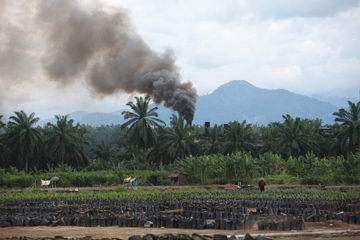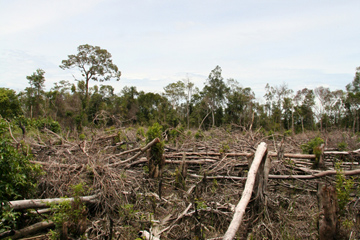A raft of new studies show that protecting Southeast Asia’s forests could provide an enormous economic lift for Southeast Asia. Indeed, the studies suggest, forest conservation, sustainable forestry, and agricultural improvements, along with investments in clean energy, could spur the rise of regional “Green Tiger” economies whose development levels surpass even those achieved during the boom years of the 1990’s. The studies provide a striking rebuttal to palm oil and timber industries’ claims that deforestation is necessary for the region’s growth.
Perhaps the most authoritative assessment (pdf) comes from the Rajawali Institute for Asia at the Harvard Kennedy School of Government. Its broad study of Indonesia’s economy and government pegs over-exploitation of natural resources, and deforestation in particular, as primary obstacles to Indonesia’s growth. The report estimates that by eliminating its natural capital for negligible gains, deforestation caused losses of $150 billion to Indonesia between 1990 and 2007, wiping out a whopping one third of Indonesia’s national savings during that period.
Recent on-the-ground studies from Indonesia echo the Harvard findings. As Rhett Butler reported:
 Rainforest in Sumatra, Indonesia. Photo by Rhett A. Butler |
“An investigation by a task force set up by President Susilo Bambang Yudhoyono found that deforestation in Central Kalimantan costs the province 158.5 trillion rupiah ($17.6 billion). A separate analysis published this week by Indonesian Corruption Watch estimated state losses from deforestation country-wide at 71 trillion Rupiah ($8 billion) between 2005 and 2009, or roughly $1.6 billion per year.”
Deforestation hasn’t just caused monetary losses, it’s also resulted in an unemployment surge in key natural resources sectors. In Indonesia, for instance, clear-cutting and conversion of forests to palm oil is so widespread that it’s drastically reduced the availability of wood available to be cut and processed. Without timber to cut, employment in the country’s forest products sector had plummeted 50 percent by 2007, with further losses likely since then. It’s estimated that Jambi province, once a major forest products producer, has lost 76,000 jobs in the sector. This decline of available wood due to overharvesting has spurred the Indonesian forestry workers’ union Katuhindo to call for a ban on harvesting pristine forests and instead relying exclusively on reforestation for wood and fiber.
The most tangible financial benefits for Indonesia and Malaysia will come through international forest finance programs such as REDD+ (Reducing Emissions from Deforestation and Degradation) which would compensate the countries for protecting their forests – approximately $16 billion by 2020 (pdf) and significantly greater after that.
The numbers also do not take into account several other factors likely to further boost revenues for non-deforestation agriculture, notably yield improvements. Average palm oil yields in Indonesia and Malaysia currently about 2.5 tons per hectare, while intensively managed plantations are already generating yields of 10 tons per hectare, with more improvement expected. As a recent study from the Center for International Forestry discusses, simple steps like not allowing old palm oil trees to rot in the field and cultivate the parasite Ganoderma could help significantly. Even without reaching the levels of the most modern plantations, an average 50 percent yield improvement would produce 18 million more tons of oil without cutting down one additional tree.
While protecting forests offers enormous positive economic opportunities, there are also major economic risks for Southeast Asia’s agriculture and timber sectors if they don’t take prompt action to conserve their forests. Global consumers are increasingly demanding deforestation-free products. Nestle, Unilever, McDonald’s and others have all pledged to get 100 percent of their palm oil from sources certified “sustainable” by the Roundtable on Sustainable Palm Oil, which is supposed to indicate that they are grown on land not deforested since 2005 (though major loopholes remain in the RSPO that still allow deforestation for certified palm oil). Consumer brands like Girl Scout cookies and Mattel‘s Ken and Barbie toys have recently come under serious fire for consumers for using products linked to deforestation in Southeast Asia. And major financial institutions HSBC have dropped investments in companies linked to deforestation, while Wall Street more broadly is chary of the reputational risk involved in the sector.
 Oil palm plantation and mill in North Sumatra  Deforestation in Kalimantan, Indonesian Borneo. Photos by Rhett A. Butler. |
These global consumer risks are exacerbated because of the emergence of Brazil as a potential deforestation-free competitor to supply the world with palm oil. Although Brazil continues to struggle with a spike in deforestation linked to illegal logging, cattle ranching, and dam construction, the country has also delivered significant reductions in deforestation in the past. Although it accounts for just .5 percent of global palm production, its Sustainable Palm Oil plan envisions expanding that to 35 percent, and do it through planting on its millions of hectares of available lands. Given Brazil’s advanced agricultural technology and deployment capability, and current yields in its palm oil sector, it’s likely that its yields could far outstrip those currently being achieved in Southeast Asia. In the absence of a shift away from deforestation in Indonesia and Malaysia, Brazil may be able to claim significant market share by providing a major new source of zero deforestation palm oil, significantly cutting into Southeast Asia’s historical dominance.
Overall, of course, the economic benefits of conservation in Southeast Asia will reach far beyond the agriculture and forestry sectors into broader society. The forest fires frequently used to clear land send an enormous amount of toxic smoke into the air, blanketing the whole region in haze. According to The Rand Corporation, particularly intense fires in Indonesia and Malaysia have increased deaths by 22 percent. Bad air quality can also send people to the hospital and increase asthma attacks, lowering productivity. One of Southeast Asia’s challenges is attracting global companies to locate high-level executive headquarters in the region, in part because of the intense air pollution exacerbated by forest fires.
Coastal deforestation presents special risks. Widespread deforestation of Indonesia’s coastal mangrove forests deprived the country of its natural buffer with the sea. Studies have shown that mangrove forests can reduce tsunami flow by as much as 90 percent. During the giant 2004 tsunami, villages that had cut down their mangroves were often wiped out while those that maintained them fared much better. Though mangrove deforestation has been widespread throughout Asia, it has been particularly intense in Indonesia, and is thought to be a significant factor in why Indonesia fared much worse than neighbors who had done a better job of protecting their forests.
With Southeast Asia so vulnerable to typhoons, storms, and tsunamis, intact forests provide a vital buffer for people and the economy – and a path to far greater prosperity.
Glenn Hurowitz is a senior fellow at the Center for International Policy.